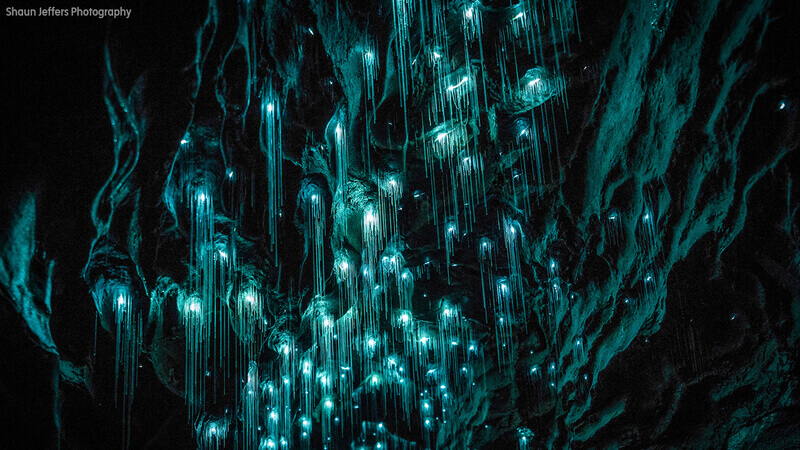Sure, the Waitomo Caves are visually spectacular with their frantic rock formations and glowworm caves. Still, their history, discovery, and residents indicate that there’s more to the Waitomo Caves than meets the eye. This prevalent New Zealand sight is well worth exploring further. With that in mind, we’ve compiled this collection of amazing Waitomo Caves facts!
Seeing the caverns is only half the fun, but learning a little more about the caves will give you a richer experience. By the way, for things to do in Waitomo both on and off the ground, check out the Complete Guide to Waitomo.
Facts 1: Worms are not Glowworms!

But they shine! The glowworms living in Waitomo Cave in New Zealand are a type of gnat called Arachnocampa Luminosa. When you see them shining, that’s the larval stage, when they’re more like a maggot than a worm.
Facts 2: Waitomo is home to hundreds of caves.
Many people are only familiar with the three famous caves in Waitomo, but did you know there are hundreds of caves? There are also roughly ten caves that may be explored on trips! Visit New Zealand’s Best Glowing Worm Caves to learn more.
Facts 3: The Waitomo Caves first appeared 30 million years ago.

The impressive stalactites and stalactites formed from the bones and shells of aquatic life are made of limestone. These marine fossils solidify on the seafloor over millions of years, forming sedimentary rocks. Tectonic activity brought this sedimentary rock with New Zealand out of the water. Then, about 1 million years ago, rain caused enormous cracks in the rock, which eventually formed the cave we see today. (At least, that’s the short version of the story.)
Facts 4: Glowing Worms Glow to attract insects.
Glowworms, like travelers, light to lure other insects to the long sticky strings they hang from the ceiling. They also use bioluminescence produced by their tails to attract mates. Blue light is produced when chemicals in their tails react with oxygen.
Facts 5: In Waitomo Caves, you may see Glowworms for free.

Waitomo offers a variety of exciting ways to view luminous bugs. There are, however, some locations where you can relax and explore the glowing worms for free. One evening, take the torch to the Ruakuri boardwalk to discover the glowworms along the trail.
Facts 6: Waitomo translates as “Water Hole.”
“Wai” refers to water, while “tomo” refers to a hole or entrance. Meaningful!
Facts 7: Waitomo Caves dwellers aren’t limited to glowworms.
Waitomo Cave is home not just to glowworms, but also to another incredible bug known as a weta cave. The Weta, also known as the cave cricket, is only found in New Zealand. There are 70 different species, with the enormous Weta being the world’s heaviest insect. They’ve also seen dinosaurs come and go over millions of years. Discover more about New Zealand’s exciting biodiversity with our list of the 20 most unusual New Zealand animals and birds.
Facts 8: People have been visiting the caves for more than a century.

Tane Tinorau, a Maori chief, is reported to have been the first to find the Waitomo Caves in the 1800s. Local Maori guides began investigating the caves with a local surveyor after visiting the caves with a local surveyor. In 1904 he was the first to transport tourists into the cave.
Facts 9: Adult glowworms have a limited lifespan.
After around ten months, eggs, juvenile larvae, cocoons, and adult glowworms emerge. On the other hand, adult flies cannot feed, so they can make the most of their time by mating and laying eggs until they die about 2-3 days later.
Facts 10: Touching limestone features can cause them to deteriorate.
When visiting the Waitomo Caves, remember that touching the limestone features can cause them to deteriorate. Waitomo Caves’ stalactites, stalagmites, pillars, and spirals formed over thousands of years. Limestone is brittle, and the chemicals in our skin can also react negatively with it.
Top Things To Do in New Zealand After Dark
Fun Facts About Wildlife in New Zealand
The most interesting Maori legends and myths you should know

This actually answered my drawback, thanks!